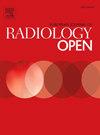Diagnostic accuracy and added value of dynamic chest radiography in detecting pulmonary embolism: A retrospective study
IF 2.9
Q3 RADIOLOGY, NUCLEAR MEDICINE & MEDICAL IMAGING
引用次数: 0
Abstract
Purpose
This study aimed to assess the diagnostic performance of dynamic chest radiography (DCR) and investigate its added value to chest radiography (CR) in detecting pulmonary embolism (PE).
Methods
Of 775 patients who underwent CR and DCR in our hospital between June 2020 and August 2022, individuals who also underwent contrast-enhanced CT (CECT) of the chest within 72 h were included in this study. PE or non-PE diagnosis was confirmed by CECT and the subsequent clinical course. The enrolled patients were randomized into two groups. Six observers, including two thoracic radiologists, two cardiologists, and two radiology residents, interpreted each chest radiograph with and without DCR using a crossover design with a washout period. Diagnostic performance was compared between CR with and without DCR in the standing and supine positions.
Results
Sixty patients (15 PE, 45 non-PE) were retrospectively enrolled. The addition of DCR to CR significantly improved the sensitivity, specificity, accuracy, and area under the curve (AUC) in the standing (35.6–70.0 % [P < 0.0001], 84.8–93.3 % [P = 0.0010], 72.5–87.5 % [P < 0.0001], and 0.66–0.85 [P < 0.0001], respectively) and supine (33.3–65.6 % [P < 0.0001], 78.5–92.2 % [P < 0.0001], 67.2–85.6 % [P < 0.0001], and 0.62–0.80 [P = 0.0002], respectively) positions for PE detection. No significant differences were found between the AUC values of DCR with CR in the standing and supine positions (P = 0.11) or among radiologists, cardiologists, and radiology residents (P = 0.14–0.68).
Conclusions
Incorporating DCR with CR demonstrated moderate sensitivity, high specificity, and high accuracy in detecting PE, all of which were significantly higher than those achieved with CR alone, regardless of scan position, observer expertise, or experience.
动态胸片在检测肺栓塞方面的诊断准确性和附加值:回顾性研究
目的 本研究旨在评估动态胸部放射摄影(DCR)的诊断性能,并探讨其在检测肺栓塞(PE)方面对胸部放射摄影(CR)的附加价值。方法 在 2020 年 6 月至 2022 年 8 月期间,在我院接受 CR 和 DCR 检查的 775 例患者中,纳入了 72 小时内同时接受胸部对比增强 CT(CECT)检查的患者。PE或非PE的诊断由CECT和随后的临床病程证实。入组患者被随机分为两组。包括两名胸部放射科医生、两名心脏病医生和两名放射科住院医师在内的六名观察者采用交叉设计和冲洗期对每张使用和未使用 DCR 的胸片进行判读。结果回顾性纳入了 60 名患者(15 名 PE 患者,45 名非 PE 患者)。在 CR 中添加 DCR 后,站立位的敏感性、特异性、准确性和曲线下面积(AUC)均有明显改善(35.6-70.0 % [P < 0.0001]、84.8-93.3 % [P = 0.0010]、72.5-87.5 % [P < 0.0001], and 0.66-0.85 [P < 0.0001], respectively) and supine (33.3-65.6 % [P < 0.0001], 78.5-92.2 % [P < 0.0001], 67.2-85.6 % [P < 0.0001], and 0.62-0.80 [P = 0.0002], respectively) positions for PE detection.结论将 DCR 与 CR 结合在一起在检测 PE 方面表现出中等灵敏度、高特异性和高准确性,无论扫描体位、观察者的专业知识或经验如何,其灵敏度、特异性和准确性均明显高于单独使用 CR 所达到的结果。
本文章由计算机程序翻译,如有差异,请以英文原文为准。
求助全文
约1分钟内获得全文
求助全文
来源期刊

European Journal of Radiology Open
Medicine-Radiology, Nuclear Medicine and Imaging
CiteScore
4.10
自引率
5.00%
发文量
55
审稿时长
51 days
 求助内容:
求助内容: 应助结果提醒方式:
应助结果提醒方式:


